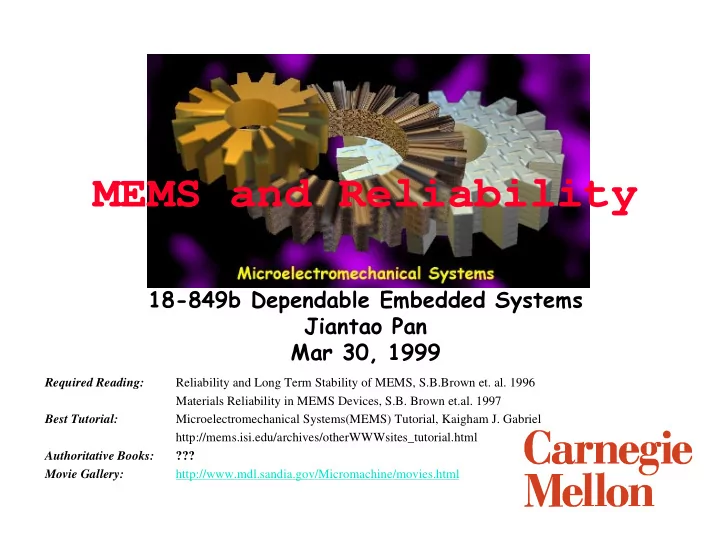

MEMS and Reliability ����������������������������������� ����������� ������������ Reliability and Long Term Stability of MEMS, S.B.Brown et. al. 1996 Required Reading: Materials Reliability in MEMS Devices, S.B. Brown et.al. 1997 Microelectromechanical Systems(MEMS) Tutorial, Kaigham J. Gabriel Best Tutorial: http://mems.isi.edu/archives/otherWWWsites_tutorial.html ??? Authoritative Books: http://www.mdl.sandia.gov/Micromachine/movies.html Movie Gallery:
You Are Here ��������� ������������ 2
Introduction ◆ What is MEMS(MicroElectroMechanical Systems) • Microelectromechanical systems (MEMS): – are integrated micro devices or systems – combine electrical and mechanical components – are fabricated using integrated circuit (IC) compatible batch-processing techniques – range in size from micrometers to millimeters. – can sense, control, and actuate on the micro scale – can function individually or in arrays to generate effects on the macro scale. • Revolutionizing “traditional” mechanical and materials engineering into “high-tech”. • The next logical step in the silicon revolution. • $10 Billion market today, $34 Billion market in 2002 • Fascinating, amazing, … ◆ DARPA MEMS program Goal: • co-located perception, processing and control 3
Applications:Size DOES Matter ◆ Optical switching: • Integrated Optics, Micro-optics ◆ Embedded sensors & actuators • Inertial: accelerometers that deploy car airbags • Pressure ◆ Biomedical devices • Non-invasive biomedical sensors ◆ Microfluidics • Inkjet-printer cartridges • Miniature analytical instruments • Chip-based DNA processing & sequencing • Propellant and combustion control • Chemical factories on chip ◆ Mass data storage • Terabytes per square centimeter ◆ Low-power, high-resolution small displays ◆ Microinstruments & Micromachines • Micropumps ◆ Microrobots 4
MEMS Fabrication ◆ “System on a chip”: a miniature embedded system itself • Including computing, sensing and actuating parts • Similar to IC manufacturing process • Usually fabricated completely assembled -- no piece parts ◆ Characteristics of Fabrication • Miniaturization • Multiplicity • Microelectronics ◆ Fabrication methods and materials • Bulk micromachining • Wafer-to-wafer bonding • High-aspect ratio micromachining • Surface micromachining 5
Fabrication Procedures ◆ Significant distinctions between MEMS and ICs are noted in bold italics. Source: Electronics Technology Office, DARPA 6
Typical Size ◆ “The technologies and applications of three-dimensional devices with sizes in the micrometer ranges.” ◆ Spider mite raids microlock • This is not Godzilla. This is a spider mite (a miniscule, white fleck to the human eye) hanging out on a microlock mechanism. Note the scale key in the lower right corner. 7
Reliability of MEMS ◆ More than just Electro+Mechanical failures • Mechanical reliability • Electrical reliability • Material reliability • Interactions of mechanical and electrical part ◆ Macro failure modes not applicable ◆ Unique failure modes at microscopic level • Static overload • Delamination • Creep • Environmental attack • Fatigue 8
Root Causes ◆ Capillary forces • Liquid-air interface induced in etching • Stiction happens even without liquid; aggravated by moisture ◆ Operational Methods • Drive signals not comply to mechanical model – e.g. MEMS actuators driven by model based drive signals have 5 orders of magnitude longer life than square wave signals in experiment. • Noise in drive signals ◆ Mechanical Instabilities • Gear position, spring shape, alignment, etc • Buckling ◆ Electrical Instabilities • Linear clamping caused by static electricity 9
Techniques for Higher Reliability ◆ Chemical surface treatments • Super-critical drying method • Hydrophobic coating ◆ Model-based operational methods • Optimized electrical drive signals • Minimized constraint forces ◆ Clever design modifications • Improved thickness, stiffness, endurance, shape, etc 10
Conclusions ◆ Revolutionary, fast growing new technology ◆ Still in its infancy • Like IC technology 30 years ago ◆ Reliability: How MEMS fail is not well understood • Study shows material strength is NOT a key factor – failures induced by deficiencies in material/mechanical properties not majority, such as fracture strength or fatigue-related fracture • Failures causes typically related to contacting or rubbing surfaces: Stiction and friction-related wear • Unique failure modes at microscopic level – Static overload, Delamination, Creep, Environmental attack, Fatigue • Reliability can be enhanced by optimized designs and better techniques 11
Future Direction Trends in electromechanical integration Log-log plot of number of transistors merged with number of mechanical components for existing and future MEMS devices and systems. 12
On the Reading Papers ◆ Reliability and Long-Term Stability of MEMS • High-level generalization of MEMS failure modes • Different failure modes in microscope v.s. macroscope ◆ Materials Reliability in MEMS Devices • An accelerated testing technique on stress/fatigue testing • Found fatigue life of poly is a function of stress • Previous work found crack growth dependent on moisture 13
Recommend
More recommend